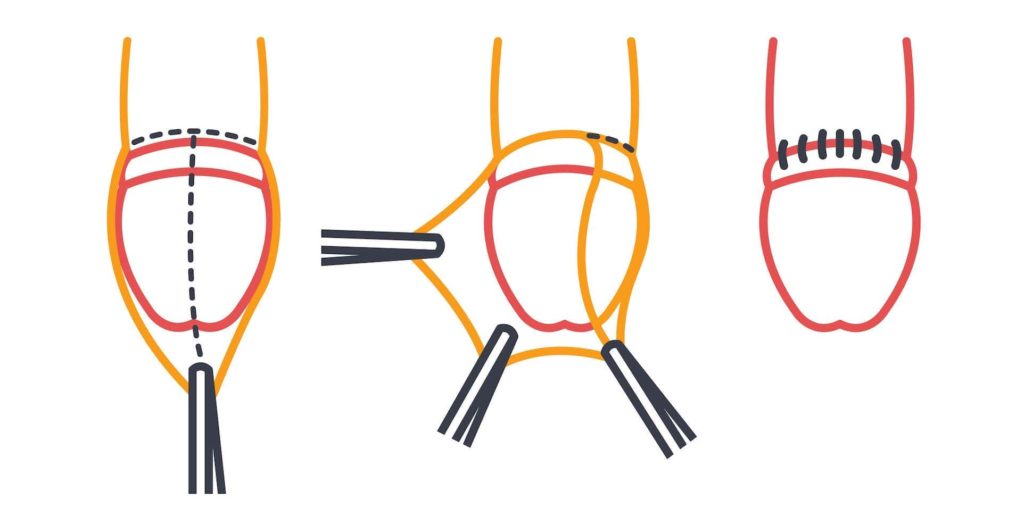The hood of skin that covers the head of the penis, also known as the glans penis, is called foreskin. Circumcision is a surgical procedure in which the foreskin on the penis is removed to expose the end of the penis. After circumcision, the glans penis is exposed permanently.
Some families may choose to circumcise their male children based on certain cultural and/or religious beliefs, while others choose to circumcise their children for reasons such as hygiene. Circumcision may also be indicated in some patients who have medical conditions such as phimosis (tight foreskin opening) and recurrent foreskin or glans penis infections. Some families, on the other hand, may elect not to circumcise their children and allow them to make the choice later.
Circumcision is usually done under general anaesthesia and is a full surgical procedure.

According to research studies, patients who are circumcised have lower risks of:
Circumcision can be done at any age. Generally the sooner the procedure is done, the lower the risk of penile cancer. That being said, other cultures may perform circumcision at a later age.
That being said, circumcision done at any age is a safe procedure that will not affect the function of the penis and quality of life. In fact, if medically indicated, circumcision can be helpful in bringing relief to current symptoms.
Circumcisions are performed by a urologist, a surgeon who is skilled in treating conditions related to the genitourinary tract. If you are keen to get a circumcision for yourself or as an option for your child, do speak to your urologist and discuss your treatment options with them.

The procedure is done under general anaesthesia, and patients will be put to sleep during the procedure. The surgery lasts for less than an hour if there are no complications.
Before the procedure, your surgeon will refer you to see an anaesthetist. The doctor will assess your medical history and your medications to help assess your fitness for surgery. In addition, certain measures may also be recommended to you before the surgery, e.g. to stop smoking 8 weeks before the surgery, to stop any blood thinner medications 1 to 2 weeks before the surgery.
The surgery process itself is fairly straightforward – the surgeon will make an incision around the foreskin and slowly remove it. Afterwards, absorbable stitches or glue will be used once the foreskin is removed, and there is no need for any suture removal after the surgery. A dressing is typically applied at the end of the surgery and can be removed within a day.
Like any surgical procedure, there are some risks with circumcision, although rare. These include:
Rarely, some people think that circumcision may also lessen the sensitivity felt over the penile head, which can have some effects on sexual function and pleasure in the long term. However, these are anecdotal reports, and there have been no studies proving this to date.
Circumcisions are generally quick and painless procedures, and usually performed as day surgery. Some medical leave will be given for up to 1- 2 weeks to allow patients to rest, but most people will be able to go back to school and work as the surgical wounds and pain heal quickly.
Circumcision is a surgery, and as such, there will invariably be pain after the procedure. Since there is general anaesthesia given during the surgery, patients will be asleep and will not be able to feel any pain during the procedure itself.
Postoperative pain is usually remedied by oral painkillers and topical analgesia given during the surgery. Sometimes, a cream containing anaesthetic can also be applied over the penis to help numb the area and relieve some discomfort.
There is usually no or minimal pain on passing urine after the procedure.
After circumcision, it is important to keep the area clean and dry; after washing the area with warm water, pat dry the penis to ensure that excessive moisture does not build up over the wound site. The wound can be left exposed.
Healing usually takes about 1-2 weeks. It is normal to notice some blood, swelling, crusting, and pain over the penis, but this should resolve as the days go on. Should your symptoms not resolve, or if you start to develop a fever, pain, bleeding that is prolonged, or inability to pass urine normally, do seek medical attention immediately.
Circumcision is a simple urological procedure that can be done at all ages for patients of the male sex. It generally carries a low-risk profile, and with proper care after the surgery, most patients recover well and have no further complications.

MBBS, MRCSed, MMED(Surgery)
Dr Terence Lim is a Senior Consultant Urologist with a subspecialty in Uro-Oncology. He is also the Medical Director at Assure Urology & Robotic Centre. His clinical interests include Uro-Oncology, Minimally-invasive Urological Surgery, Urinary Stone Disease, Endourology and Prostate Health.
Prior to his private practice, Dr Terence Lim spent almost two decades in public healthcare. He served as the Senior Consultant and Chief of the Department of Urology at Changi General Hospital (CGH). In addition, he is currently a Visiting Consultant at CGH. Dr Lim was also the director of CGH’s Advanced Surgical Centre, a committee dealing with complex surgeries, including robotic surgeries.
Your health is important to us and some conditions require immediate attention. For emergencies, please contact us at 9835 0668.

MBBS, MRCSed, MMED(Surgery)
Dr Terence Lim is a Senior Consultant Urologist with a subspecialty in Uro-Oncology. He is also the Medical Director at Assure Urology & Robotic Centre. His clinical interests include Uro-Oncology, Minimally-invasive Urological Surgery, Urinary Stone Disease, Endourology and Prostate Health.
Prior to his private practice, Dr Terence Lim spent almost two decades in public healthcare. He served as the Senior Consultant and Chief of the Department of Urology at Changi General Hospital (CGH). In addition, he is currently a Visiting Consultant at CGH. Dr Lim was also the director of CGH’s Advanced Surgical Centre, a committee dealing with complex surgeries, including robotic surgeries.
Your health is important to us and some conditions require immediate attention. For emergencies, please contact us at 9835 0668.
No issue is too small. Contact any of our friendly staff and we will get back to you as soon as possible.
Reach out to us for expert urological care.
For enquiries, leave a message and our friendly team will get in touch with you.
For urgent enquiries after office hours, call or WhatsApp us at (65) 9835 0668.
Monday – Friday: 9:00AM – 5:00PM
Saturday: 9:00AM – 12:30PM
Sunday & Public Holiday: CLOSED

© 2023 All Rights Reserved | Assure Urology & Robotic Centre | Terms & Conditions